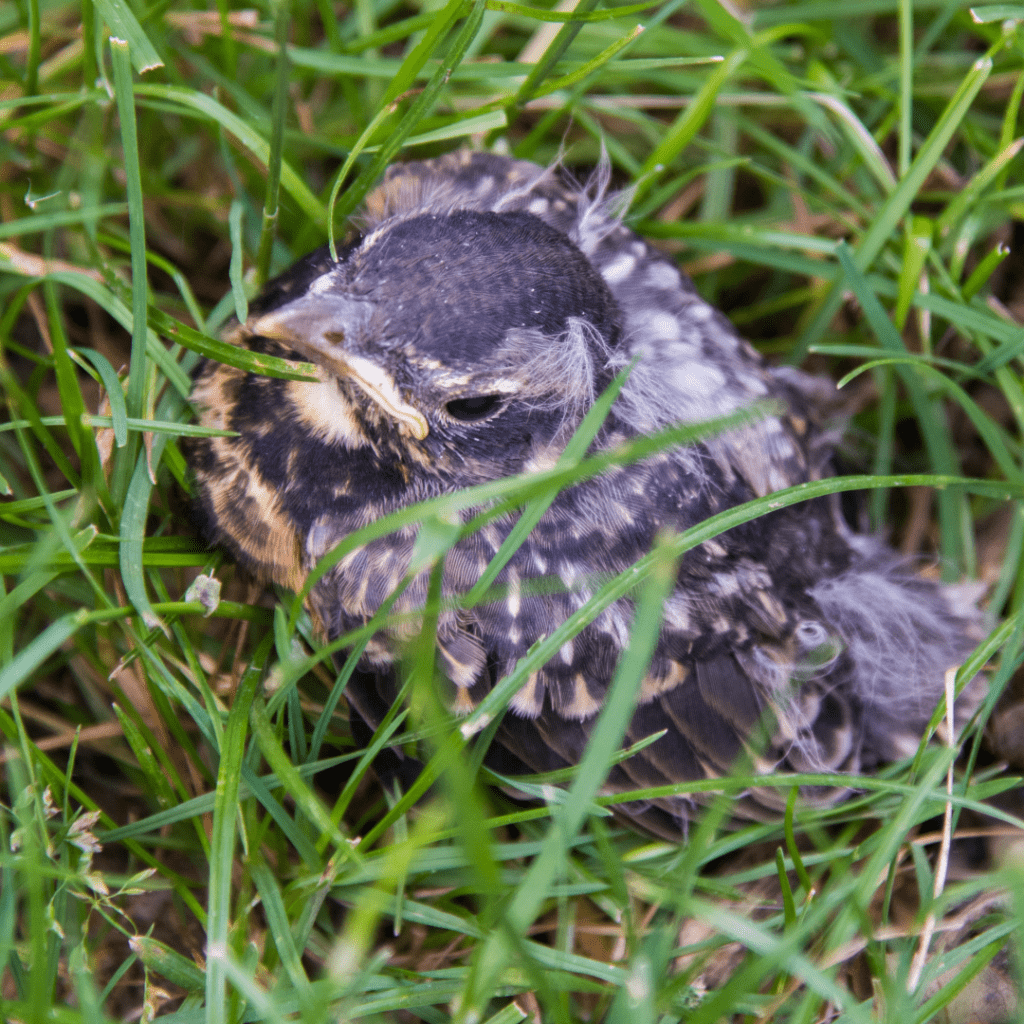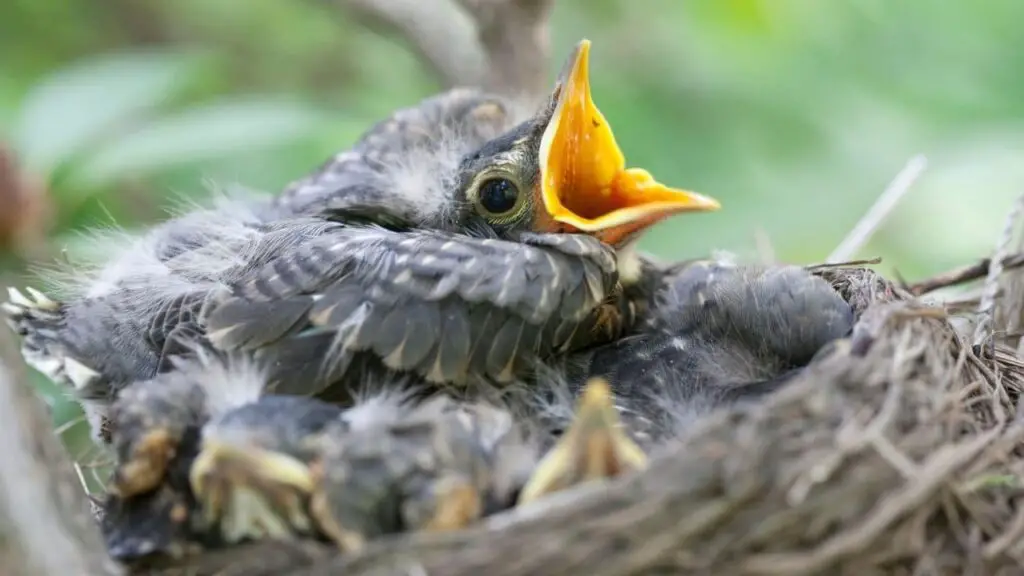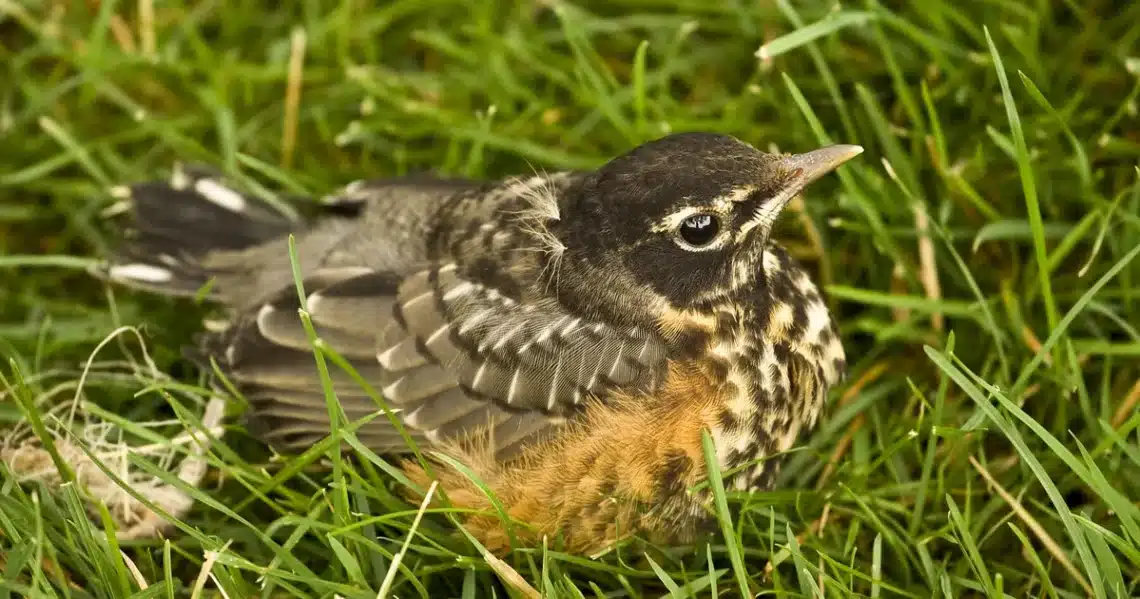Introduction
When Do Baby Robins Leave The Nest: When it comes to the world of avian wonders, few events capture our fascination and curiosity quite like the moment when baby robins leave the nest. It’s a pivotal milestone in the life of these charming birds, marking the transition from helpless chicks to independent, feathered adventurers. The departure of baby robins from their nest is a poignant spectacle of nature’s design, evoking a sense of wonder and admiration among both casual observers and seasoned ornithologists alike.
The journey to fledging, as it is known in ornithological circles, begins with the careful construction of a robin’s nest. These nests are meticulously woven from twigs, grass, and other materials, often situated in the nooks and crannies of trees, shrubs, or even human-made structures. Once the nest is completed, the female robin lays her eggs, and the incubation period begins. During this time, the mother robin is a devoted guardian, tirelessly tending to her clutch to ensure their survival.
As the eggs hatch into fragile, blind, and naked nestlings, the parents’ care intensifies. Both the mother and father robin take turns feeding their offspring, delivering a diet primarily consisting of insects and earthworms. The nestlings grow rapidly, their once featherless bodies soon adorned with downy plumage, and their eyes opening to reveal inquisitive gazes. The pivotal moment arrives when these baby robins, now known as fledglings, are ready to leave the nest. The fledglings initially perch on the edge of the nest, flapping their wings in a tentative display of newfound strength. Over the course of a few days, they take their first wobbly flights, hopping to nearby branches. These early flights are essential for honing their flying skills and building the muscles required for sustained flight.

What time of year do baby robins leave the nest?
Young leave the nest about 14-16 days after hatching. Male may tend the fledged young while female begins second nesting attempt. 2 broods per season, sometimes 3.
Nest Building (Early Spring): Female robins are primarily responsible for nest construction. They use a combination of mud, twigs, leaves, and grass to create a cup-shaped nest, which they line with softer materials like fine grass and feathers.
Egg Laying (Mid to Late Spring): After the nest is complete, the female robin lays a clutch of eggs, typically consisting of three to five eggs. These eggs are a beautiful pale blue color, often associated with robins.
Incubation (Late Spring): The female robin incubates the eggs, keeping them warm with her body. This period typically lasts around 12-14 days.
Hatching (Late Spring to Early Summer): Once the eggs hatch, the baby robins, known as nestlings, are born blind and naked. They rely entirely on their parents for food and warmth during this stage.
Feeding and Growth (Early to Mid-Summer): Both the male and female robins work tirelessly to feed their hungry chicks. Nestlings grow rapidly, and their feathers gradually develop.
Do baby robins come back to the nest?
But baby robins do tend to return to the same general locality in which they were born. So when the parents have passed on (flown to the big birdfeeder in the sky), it’s quite possible that one of the kids might occupy their old spot… once all the paperwork is squared away.
Fledging – Leaving the Nest
The term “fledging” refers to the stage when baby birds are ready to leave the nest. For robins, this typically occurs when the young birds are around 13-15 days old. At this point, the fledglings are covered in feathers and have developed enough strength to hop about the nest. It is an exciting time when the young robins take their first tentative flights away from the nest.
The answer to whether baby robins return to the nest after fledging is generally no. Once they leave the nest, they do not return to it. However, this does not mean they abandon their nesting area entirely. Instead, young robins spend the next few weeks exploring their surroundings, learning to forage for food, and honing their flying skills.
Parents’ Role
During the period immediately following fledging, the adult robin parents continue to play a crucial role in the lives of their young. They provide food and protection while the fledglings gain independence. The young robins may follow their parents around, and the adults teach them essential survival skills. This transitional phase is a critical part of a young robin’s development.
Where do baby robins go when they leave the nest?
Once baby robins have left their nest, they will travel around 1 mile away from their birthplace. They will explore their surroundings and look for their own food and a place to stay. Join a flock. If baby robins can’t find a place to stay, they may join a flock of other birds.
Exploration of Immediate Surroundings: When baby robins first fledge, they don’t venture very far from the nest. They are still inexperienced and rely on the immediate vicinity for safety and food. They often perch in nearby trees, shrubs, or even on the ground, making short flights from one spot to another.
Continued Parental Care: Fledgling robins do not become fully independent immediately. Their parents continue to play a vital role in their lives. Adult robins provide food, guidance, and protection as the young birds learn to fend for themselves. The parents may lead the fledglings to areas rich in insects, their primary food source.
Learning to Forage: One of the critical skills fledgling robins must acquire is the ability to find food. They begin to forage for insects, earthworms, berries, and other small invertebrates. Their parents teach them how to locate and capture these food items, helping them become self-sufficient.
Exploring the Territory: Over time, fledgling robins gradually expand their territory. They explore different areas within their parents’ territory, often following their parents’ lead. This exploration allows them to learn about the diverse food sources available in their environment.
How many baby robins survive?
An American Robin can produce three successful broods in one year. On average, though, only 40 percent of nests successfully produce young. Only 25 percent of those fledged young survive to November. From that point on, about half of the robins alive in any year will make it to the next.
Nestlings in the Nest: The survival rate of nestlings in the nest is relatively high. With the protection of the nest and the constant care of their parents, the majority of baby robins survive to the fledgling stage.
Fledglings Leaving the Nest: The period after fledging is the most challenging for young robins. It is estimated that only about 25% to 40% of fledglings survive to adulthood. This stage is fraught with risks as they learn to fend for themselves and navigate the complexities of the world outside the nest.
Parental Care: The survival rates of baby robins are heavily influenced by the quality of care provided by their parents. Adult robins play a critical role in protecting, feeding, and teaching their young. Their experience and vigilance can significantly impact the chances of fledglings reaching adulthood.
Habitat and Food Availability: The presence of a suitable habitat with an ample supply of insects and earthworms is vital for the survival of baby robins. Urban environments with less access to natural food sources can present greater challenges.
How long does it take a baby robin to fly?
A. Baby robins jump from their nest when they are about 13 days old. It takes them another 10-15 days to become strong fliers and independent birds.
Hatching to Nestling: When baby robins hatch, they are initially helpless, blind, and naked. At this stage, they rely entirely on their parents for warmth, protection, and food. The parents diligently care for them in the nest.
Growth and Feeding: Over the next few days, the nestlings grow rapidly. They develop soft, downy feathers, and their eyes gradually open. The parents work tirelessly to provide a diet of insects, earthworms, and other small invertebrates, ensuring their young receive the nutrition needed for growth.
Wing Development: As the nestlings continue to grow, their wing feathers start to emerge. These feathers begin as pin feathers, which are encased in protective sheaths. Slowly, the young robins gain more control over their wings.
Branching Stage: Before attempting full flight, baby robins often go through a “branching” stage, which usually occurs when they are around 9 to 11 days old. During this phase, they venture out of the nest and perch on nearby branches, practicing flapping their wings and hopping from branch to branch.
What would eat baby robins?
Crows and jays, which eat robin babies. This is a significant problem where these species are kept at artificially high numbers in cities, but otherwise is offset by the help crows and jays give robins in warning about other dangers. Hawks, shrikes, and owls, which kill and eat robins.
Snakes: Snakes are notorious nest raiders and are among the most common predators of baby robins. Species such as black snakes and rat snakes are known for their climbing abilities, allowing them to access nests in trees or shrubs.
Squirrels: Tree-dwelling rodents like squirrels are agile climbers and are capable of reaching robin nests. They often consume both eggs and nestlings, making them a threat to baby robins.
Cats: Domestic cats, as well as feral cats, pose a significant danger to baby robins. Their hunting instincts lead them to explore bird nests, and they may catch nestlings if given the opportunity.
Birds of Prey: Raptors like hawks and owls are skilled hunters and may target baby robins. They are more likely to prey on fledgling robins once they have left the nest and are still learning to fly.
Corvids: Crows and jays, members of the corvid family, are known to consume both robin eggs and nestlings. Their intelligence and adaptability make them formidable nest predators.
Can a baby robin survive on the ground?
If you find a hatchling on the ground, they need help, since they are unable to fend for themselves and will likely die without assistance. A nestling is slightly older than a hatchling but is still not capable of being on its own.
Parental Care: Parent robins do not abandon their young just because they are on the ground. In fact, they continue to provide food and protection for their fledglings during this phase. The parents may even lead their offspring to suitable foraging areas.
Camouflage: Young robins on the ground often have speckled breasts that provide some natural camouflage in their surroundings. This can help them avoid the attention of potential predators.
Learning to Fly: Being on the ground is a part of the learning process for fledgling robins. It allows them to practice hopping, fluttering, and short flights, gradually building the skills they need to become proficient flyers.
Feeding: On the ground, baby robins learn to forage for food. They search for insects, earthworms, berries, and other small invertebrates, honing their hunting skills.
What do robins do if a baby dies in the nest?
Q: If they die does the mom or dad remove the body from the nest? A: Sometimes one of the parents does carry off a dead nestling. This promotes nest sanitization, keeping the other nestlings safer from bacteria, maggots and flies, and other health hazards.
Removal of the Body: Adult robins often remove the deceased nestling from the nest. This behavior serves multiple purposes. It helps maintain hygiene within the nest, preventing the spread of disease. It also removes the scent of the deceased, which could potentially attract predators to the nest.
Protection and Care: Even in the face of loss, adult robins continue to care for the remaining nestlings. They provide warmth, protection, and food to ensure the survival and well-being of the surviving young.
Continued Nest Maintenance: Adult robins are known to make efforts to maintain the nest’s cleanliness and integrity. They may add more nesting material or make repairs if needed, reinforcing their commitment to the remaining offspring.
Vigilance: The parents remain vigilant to protect the nest and the living nestlings from potential threats, such as predators or adverse weather conditions.
Increased Feeding: In some cases, the parents may increase their efforts to provide food for the surviving nestlings, compensating for the loss by ensuring the remaining offspring receive adequate nourishment.

Conclusion
The departure of baby robins is not just a moment in time; it is a profound transition. It marks the culmination of weeks of dedicated care and nurturing by their parents, who have diligently fed, warmed, and protected their young. This parental devotion ensures the survival of these fledglings, allowing them to embark on their own adventures with the skills and strength needed to thrive.
As these young robins leave the nest, they enter a world full of challenges and opportunities. They must continue to learn and adapt, honing their flying skills, foraging abilities, and social interactions. Their survival is a testament not only to their resilience but also to the interconnectedness of all living beings within an ecosystem. They play a vital role in controlling insect populations, which, in turn, helps maintain ecological balance.
The departure of baby robins is also a poignant reminder of the delicate balance that exists in the natural world. Their lives are intricately woven into the fabric of their habitat, and their wellbeing is a reflection of the health of their environment. It underscores of preserving and protecting the habitats that sustain these and countless other species.


No Comments